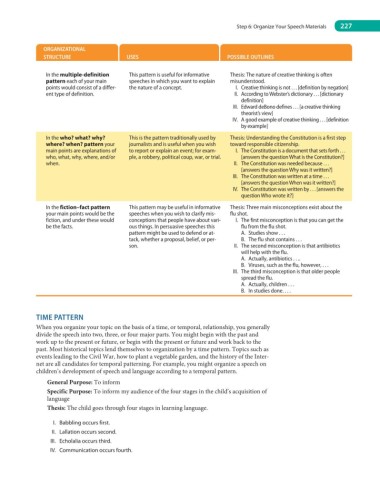Page 248 - Essentials of Human Communication
P. 248
Step 6: Organize Your Speech Materials 227
OrganiZatiOnal
structure uses POssiBle Outlines
In the multiple-definition This pattern is useful for informative Thesis: The nature of creative thinking is often
pattern each of your main speeches in which you want to explain misunderstood.
points would consist of a differ- the nature of a concept. I. Creative thinking is not . . . [definition by negation]
ent type of definition. II. According to Webster’s dictionary . . . [dictionary
definition]
III. Edward deBono defines . . . [a creative thinking
theorist’s view]
IV. A good example of creative thinking . . . [definition
by example]
In the who? what? why? This is the pattern traditionally used by Thesis: Understanding the Constitution is a first step
where? when? pattern your journalists and is useful when you wish toward responsible citizenship.
main points are explanations of to report or explain an event; for exam- I. The Constitution is a document that sets forth . . .
who, what, why, where, and/or ple, a robbery, political coup, war, or trial. [answers the question What is the Constitution?]
when. II. The Constitution was needed because . . .
[answers the question Why was it written?]
III. The Constitution was written at a time . . .
[answers the question When was it written?]
IV. The Constitution was written by . . . [answers the
question Who wrote it?]
In the fiction–fact pattern This pattern may be useful in informative Thesis: Three main misconceptions exist about the
your main points would be the speeches when you wish to clarify mis- flu shot.
fiction, and under these would conceptions that people have about vari- I. The first misconception is that you can get the
be the facts. ous things. In persuasive speeches this flu from the flu shot.
pattern might be used to defend or at- A. Studies show . . .
tack, whether a proposal, belief, or per- B. The flu shot contains . . .
son. II. The second misconception is that antibiotics
will help with the flu.
A. Actually, antibiotics . . ..
B. Viruses, such as the flu, however, . . .
III. The third misconception is that older people
spread the flu.
A. Actually, children . . .
B. In studies done. . . .
tiMe Pattern
When you organize your topic on the basis of a time, or temporal, relationship, you generally
divide the speech into two, three, or four major parts. You might begin with the past and
work up to the present or future, or begin with the present or future and work back to the
past. Most historical topics lend themselves to organization by a time pattern. Topics such as
events leading to the Civil War, how to plant a vegetable garden, and the history of the Inter-
net are all candidates for temporal patterning. For example, you might organize a speech on
children’s development of speech and language according to a temporal pattern.
General Purpose: To inform
Specific Purpose: To inform my audience of the four stages in the child’s acquisition of
language
Thesis: The child goes through four stages in learning language.
I. Babbling occurs first.
II. Lallation occurs second.
III. Echolalia occurs third.
IV. Communication occurs fourth.

